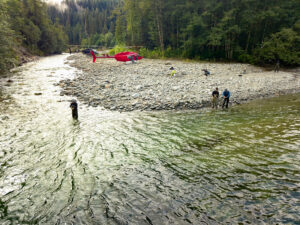
Wildlife
Do not disturb: Practicing ethical wildlife photography
Wildlife photographers on the thrill of the chase — and the importance of setting ethical guidelines
- 2849 words
- 12 minutes
This article is over 5 years old and may contain outdated information.
Travel

“It’s too white. I can’t land,” pilot Craig Roy’s voice crackles over the radio as he inches the B2 helicopter toward a snow-plastered ridge in the Skeena Range of northern British Columbia.
A blizzard of rotor wash obliterates any vision, and without rocks or trees for reference, the machine could be slipping in any direction and he’d never know. Peeling away, Roy banks hard and tries another approach. Winds buffet the helicopter, and as he nears the ridge, visibility is still completely obscured.
“Drop a nail,” the veteran pilot mutters as he fights to keep the machine steady. Roy has logged more than 10,000 hours, and flown with Skeena Heliskiing since its inception 14 years ago.
Sitting in the co-pilot seat, Giacum “Jake” Frei, head guide and founder of Skeena Heliskiing, pulls a rusty spike from his pocket, loops a tail of fluorescent flagging tape around it, then tosses it out the window. Roy circles back and this time, using only the nail for orientation in an otherwise complete whiteout, manages to touch one skid down, just long enough for Frei to hop out. Then the helicopter peels away.
Scrambling up the ridge, Frei guides the chopper toward a plateau near the summit of Mount Baldy. It lands so close to him that the front windshield touches his jacket. As the rotors whine to a halt, the pair begins lugging heavy batteries, solar panels and an antenna to the peak, where they erect a seasonal VHF radio repeater.
At their feet, a sea of snow-capped peaks spills to the horizons, ridges dotted with Engelmann spruce and subalpine fir. It’s a land vast enough to disappear into, and indeed this is where Gunanoot, the famed Gitxsan outlaw, evaded capture for 13 years during one of the longest manhunts in Canadian history. It’s also home to one of the world’s largest heli-skiing tenures. And in the days ahead, as Frei and his guides organize for their season, I tag along to glimpse just what’s entailed in preparing a 9,500-square kilometre roadless wilderness — an area nearly twice the size of Prince Edward Island — for operation.









Are you passionate about Canadian geography?
You can support Canadian Geographic in 3 ways:

Wildlife
Wildlife photographers on the thrill of the chase — and the importance of setting ethical guidelines

Wildlife
This past summer an ambitious wildlife under/overpass system broke ground in B.C. on a deadly stretch of highway just west of the Alberta border. Here’s how it happened.

Wildlife
An estimated annual $175-billion business, the illegal trade in wildlife is the world’s fourth-largest criminal enterprise. It stands to radically alter the animal kingdom.

Travel
Fly fishing for steelhead trout and salmon in Northern B.C.’s bucket list angling destination